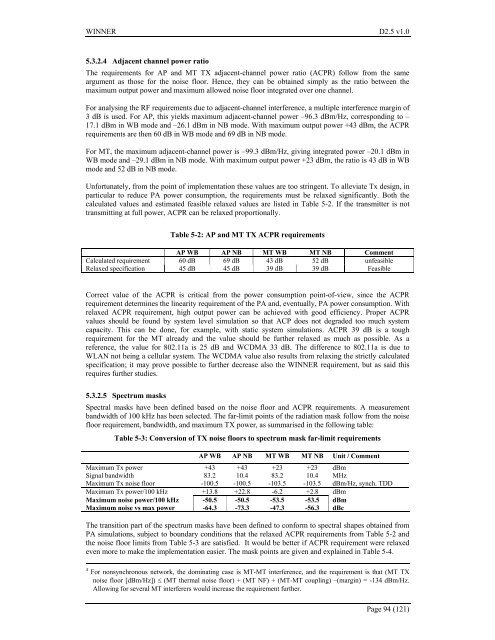IST-2003-507581 WINNER D2.5 v1.0 Duplex ... - Celtic-Plus
IST-2003-507581 WINNER D2.5 v1.0 Duplex ... - Celtic-Plus
IST-2003-507581 WINNER D2.5 v1.0 Duplex ... - Celtic-Plus
- No tags were found...
You also want an ePaper? Increase the reach of your titles
YUMPU automatically turns print PDFs into web optimized ePapers that Google loves.
<strong>WINNER</strong> <strong>D2.5</strong> <strong>v1.0</strong>5.3.2.4 Adjacent channel power ratioThe requirements for AP and MT TX adjacent-channel power ratio (ACPR) follow from the sameargument as those for the noise floor. Hence, they can be obtained simply as the ratio between themaximum output power and maximum allowed noise floor integrated over one channel.For analysing the RF requirements due to adjacent-channel interference, a multiple interference margin of3 dB is used. For AP, this yields maximum adjacent-channel power –96.3 dBm/Hz, corresponding to –17.1 dBm in WB mode and –26.1 dBm in NB mode. With maximum output power +43 dBm, the ACPRrequirements are then 60 dB in WB mode and 69 dB in NB mode.For MT, the maximum adjacent-channel power is –99.3 dBm/Hz, giving integrated power –20.1 dBm inWB mode and –29.1 dBm in NB mode. With maximum output power +23 dBm, the ratio is 43 dB in WBmode and 52 dB in NB mode.Unfortunately, from the point of implementation these values are too stringent. To alleviate Tx design, inparticular to reduce PA power consumption, the requirements must be relaxed significantly. Both thecalculated values and estimated feasible relaxed values are listed in Table 5-2. If the transmitter is nottransmitting at full power, ACPR can be relaxed proportionally.Table 5-2: AP and MT TX ACPR requirementsAP WB AP NB MT WB MT NB CommentCalculated requirement 60 dB 69 dB 43 dB 52 dB unfeasibleRelaxed specification 45 dB 45 dB 39 dB 39 dB FeasibleCorrect value of the ACPR is critical from the power consumption point-of-view, since the ACPRrequirement determines the linearity requirement of the PA and, eventually, PA power consumption. Withrelaxed ACPR requirement, high output power can be achieved with good efficiency. Proper ACPRvalues should be found by system level simulation so that ACP does not degraded too much systemcapacity. This can be done, for example, with static system simulations. ACPR 39 dB is a toughrequirement for the MT already and the value should be further relaxed as much as possible. As areference, the value for 802.11a is 25 dB and WCDMA 33 dB. The difference to 802.11a is due toWLAN not being a cellular system. The WCDMA value also results from relaxing the strictly calculatedspecification; it may prove possible to further decrease also the <strong>WINNER</strong> requirement, but as said thisrequires further studies.5.3.2.5 Spectrum masksSpectral masks have been defined based on the noise floor and ACPR requirements. A measurementbandwidth of 100 kHz has been selected. The far-limit points of the radiation mask follow from the noisefloor requirement, bandwidth, and maximum TX power, as summarised in the following table:Table 5-3: Conversion of TX noise floors to spectrum mask far-limit requirementsAP WB AP NB MT WB MT NB Unit / CommentMaximum Tx power +43 +43 +23 +23 dBmSignal bandwidth 83.2 10.4 83.2 10.4 MHzMaximum Tx noise floor -100.5 -100.5 -103.5 -103.5 dBm/Hz, synch. TDDMaximum Tx power/100 kHz +13.8 +22.8 -6.2 +2.8 dBmMaximum noise power/100 kHz -50.5 -50.5 -53.5 -53.5 dBmMaximum noise vs max power -64.3 -73.3 -47.3 -56.3 dBcThe transition part of the spectrum masks have been defined to conform to spectral shapes obtained fromPA simulations, subject to boundary conditions that the relaxed ACPR requirements from Table 5-2 andthe noise floor limits from Table 5-3 are satisfied. It would be better if ACPR requirement were relaxedeven more to make the implementation easier. The mask points are given and explained in Table 5-4.4 For nonsynchronous network, the dominating case is MT-MT interference, and the requirement is that (MT TXnoise floor [dBm/Hz]) ≤ (MT thermal noise floor) + (MT NF) + (MT-MT coupling) –(margin) = -134 dBm/Hz.Allowing for several MT interferers would increase the requirement further.Page 94 (121)
















